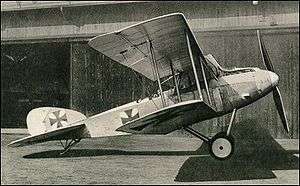Albatros C.V
| Albatros C.V | |
|---|---|
 | |
| Role | Reconnaissance aircraft |
| Manufacturer | Albatros Flugzeugwerke |
| Primary user | Luftstreitkräfte |
| Number built | ~400 |
|
| |
The Albatros C.V was a German military reconnaissance aircraft which saw service during World War I.
Design and development
The C.V was Albatros Flugzeugwerke's first revision of their B- and C-type reconnaissance aircraft since Ernst Heinkel left the firm for Hansa-Brandenburg. While retaining the same basic layout as the Heinkel-designed aircraft, the C.V featured considerably refined streamlining. The forward fuselage was skinned in sheet metal and a neat, rounded spinner covered the propeller boss. Power was provided by the new Mercedes D.IV, a geared eight-cylinder engine.
Operational history
The initial production version, designated C.V/16, suffered from heavy control forces and inadequate engine cooling. Albatros therefore produced the C.V/17 with a new lower wing, as well as balanced ailerons and elevators. The fuselage-mounted radiators were replaced by a single flush radiator in the upper wing.
These changes improved both handling qualities and engine cooling, but the downfall of the C.V was the unreliable Mercedes D.IV engine, which suffered from chronic crankshaft failures. The C.V was therefore replaced in production by the Albatros C.VII.
Variants
- C.V/16
- Original design with radiators on fuselage sides.
- C.V/17
- Revised aircraft with radiator on upper wing, and redesigned lower wing.
Operators
Specifications (C.V)
General characteristics
- Crew: two, pilot and observer
- Length: 8.95 m (29 ft 4 in)
- Wingspan: 12.78 m (41 ft 11 in)
- Height: 4.5 m (14 ft 9 in)
- Wing area: 43.4 m2 (467 ft2)
- Empty weight: 1,069 kg (2,357 lb)
- Gross weight: 1,585 kg (3,494 lb)
- Powerplant: 1 × Mercedes D.IV, 164 kW (220 hp)
Performance
- Maximum speed: 170 km/h (110 mph)
- Range: 450 km (280 miles)
- Service ceiling: 3,000 m (9,840 ft)
- Rate of climb: 2.1 m/s (410 ft/min)
Armament
- 1 × 7.92 mm (.312 in) Parabellum MG14 or Spandau LMG 08/15 machine gun for observer
- 180 kg (400 lb) of bombs
See also
References
| Wikimedia Commons has media related to Albatros C.V. |
- Taylor, Michael J. H. (1989). Jane's Encyclopedia of Aviation. London: Studio Editions. p. 52.
- Grosz, Peter M. (2002). Windsock Datafile 81 Albatros C.V. Berkhamsted: Albatros Productions Ltd.